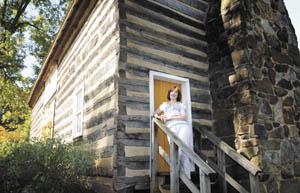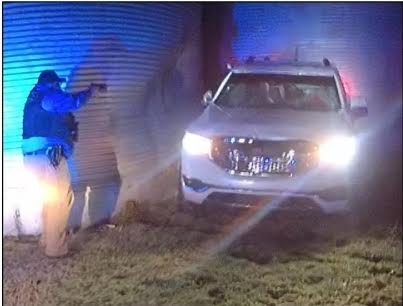Williams helps put folklore on the map
Published 12:00 am Monday, October 18, 2010

- Miranda Pederson/Daily NewsWestern Kentucky University Distinguished Professor Michael Ann Williams stands at the Felts Log House on campus.
Distinguished Professor Michael Ann Williams is out there.
Whether she is exploring log cabins in Appalachia, pondering the origins of country music or literally putting Bowling Green’s historic Shake Rag district on the map, the head of Western Kentucky University’s department of folk studies – one of only a few in the country – does not believe in hiding away in ivory academic towers.
Trending
Williams, who begins her 25th year at WKU in January, has since 2004 headed the department of folk studies, one of most successful in the U.S.
She is perhaps best known in the community for placing the Shake Rag District on the National Register of Historic Places and in folklore circles for her pioneering look at oral history and vernacular architecture in her 1993 book, “Homeplace.” But perhaps Williams is most admired by her students for her teaching and her dedication to applied folklore in addressing social issues.
“Because of the nature of the discipline, we don’t do research just for ourselves,” said Williams, who believes in putting her scholarship to work for the public good. “We do things we want to share with people.”
Her research interests include the social and symbolic use of space in vernacular architecture, government policy and its influence on Appalachian communities and oral history. Recently, Williams and her graduate students worked on an oral history project documenting a former logging town in North Carolina as a cultural resource in the transfer of land from the Great Smoky Mountains National Park to the Eastern Band of Cherokee Indians.
Thanks to Williams and her students, the Shake Rag Historic District – recognized for its significance in African-American history – was placed on the national register in 2000.
“There was no African-American district in Bowling Green and there was not a lot of recognition of it,” Williams said. “If you were not African-American or connected to the community, nobody knew what it was. That was something that I think once it happened, local people really gave it legs and it just kept going.”
Trending
Williams has also helped make WKU’s folk studies program a destination for folklore scholars, according to WKU President Gary Ransdell.
“Michael Ann has helped us carve a special niche for those who want to pursue a degree in folk studies,” Ransdell said. “She and her fellow faculty have taken our rich Kentucky heritage, our Kentucky Museum collections and a cohesive blend with anthropology to create a wonderful folklore curriculum.”
Sarah Milligan, a former student who is now administrator for the Kentucky Oral History Commission of the Kentucky Historical Society, is a product of that curriculum.
“She challenges students to learn the material, but also to articulate their knowledge and be able to put it into context,” Milligan said. “Instead of knowing about something, I understood what it was and how it fit into the working context of the field. I would say that is one of her greatest strengths – she gets to know her students, evaluates their strengths and weaknesses and helps them build on both. She does a great job helping you find and fit in your niche.”
For Williams, a native of Bethesda, Md., finding her own niche in folklore came naturally as the child of two radio personalities in the 1940s. Her father also taught broadcasting at American University and encouraged Williams to follow her own passions, which led to a Ph.D. from the University of Pennsylvania, then to WKU two weeks after submitting her dissertation.
WKU has had a folklore program since the 1920s. Now more than 35 years old, the master’s program is considered one of the country’s best master’s-only programs. The program has a built a reputation as a leader in training folklorists for work in the public sector and in historic preservation.
“We have been somewhat less ivory tower than some of the other programs,” said Williams, who has something of a reputation of throwing her students right into the folklore frying pan. “Not that we don’t promote scholarship – we are out there doing it, and these public programs have really grown in the last 30 years.”
“I get people out there doing real projects and real work. That’s really important for graduate students,” she added. “They need to leave this program with professional skills already developed. The more we can make that happen for them so they grow in confidence and they know what they can do, the more marketable they are.”
One project that began in Williams’ course on vernacular architecture is now the subject of a documentary airing this month on Kentucky Educational Television.
Former student Amber Ridington, a folklore doctoral candidate at Memorial University of Newfoundland, produced and directed the film, “Rovers, Wrestlers & Stars,” about the rich heritage of Bowling Green’s old Quonset Auditorium.
“Dr. Williams demands a lot from her students, and that is what makes her such a good teacher,” Ridington said. “She has been a tremendous influence on me as a folklorist, in particular her understanding of the contribution that oral history can make to the study of material culture has been influential for me, and has made a mark in the field of folklore as well.”
Ridington also noted that Williams has been a champion of applied folklore, which is not always the case with academics.
“She is keenly aware of the politics of cultural representation and shares her understanding of the complex nature of cultural display with her students and colleagues,” Ridington said. “She is also a dedicated administrator and has worked hard to build excellent resources and staff for the folk studies program at WKU.”
Willliams’ own work earned her the Abbott Lowell Cummings Award for outstanding work in North American vernacular architecture scholarship and the South East Society of Architectural Historians Author Award for “Homeplace,” about the social use and meaning of folk dwelling in southwestern North Carolina. Her book “Great Smoky Mountains Folklife” was published in 1995.
Williams has also presented papers about “hillbilly” music, Eastern Cherokee log dwellings and the careers of John Lair and Sarah Gertrude Knott. She has also taught courses on a wide variety of subjects, from preservation techniques to Appalachian folklife and foodways, and directed theses on topics ranging from horsetrading to pre-Lent celebrations.
She has served as chair of the Kentucky Historic Preservation Review Board, is an advisor to the Kentucky Oral History Commission and has been an active member of the Vernacular Architecture Forum, a national organization that encourages the study and preservation of architectural resources.
Among many professional accolades, Williams was awarded the WKU Outstanding Faculty Award for Research in 1996 and the Potter College Faculty Award for Service in 2002. Williams’ service to WKU has included many academic advisory councils, the university’s press committee, faculty research committee, awards committee and provost search committee, among others.
While Williams heads a nationally known program, she believes there is room for it to grow and plans to see that it does.
“I have a lot of ambitions for this program,” she said. “Even though we are very prominent in the discipline, I think there is room for us to be even bigger as a department and to be attracting even more students to Western.”






